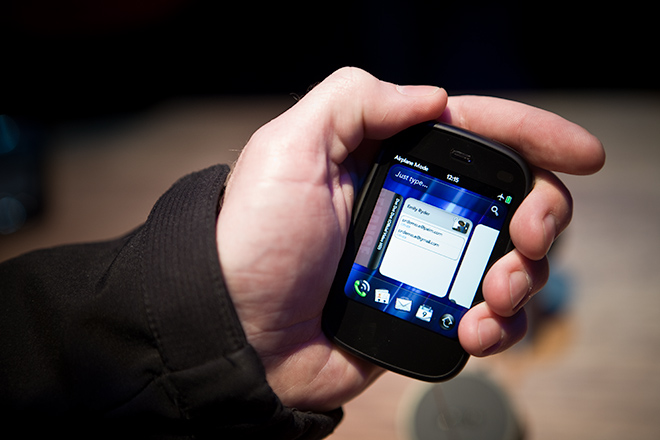
SAN FRANCISCO — HP’s diminutive Veer might be named that because the company wants to emphasize that it’s swerving in a different direction than most phone makers.
And it is: In a gadget season dominated by 4-inch and bigger smartphones, the webOS-based Veer looks positively petite. It feels like a small river rock in your hand, smooth and black and more pebble-like than any other recent phone. It should fit in a pants pocket as easily as a pocket knife, but without the TSA hassles.
Overall, it is about the size of a credit card, as HP’s senior vice president Jon Rubinstein claimed during Wednesday’s press conference announcing the Veer, along with the HP TouchPad and Pre 3. More accurately, it’s about the size of a stack of 10 or 12 credit cards. The screen’s much smaller, however. At 2.6 diagonal inches, it’s about the half the size of a business card. While bright, it’s definitely not big.
At 320 x 400 pixels, you’re not going to be reading Moby Dick on this screen, but it’s serviceable for looking at your calendar, reading text messages and composing e-mails. I checked out Wired’s website, which looked fine in the mobile version, but became much harder to read when we switched to the normal, full version of the site. Still, the Veer’s WebKit-based browser rendered everything faithfully.
The screen was reasonably responsive. The 800-MHz Qualcomm Snapdragon processor inside isn’t anything to write home about, but it should handle basic browsing and screen work just fine.
Like other webOS phones, the Veer will serve as a mobile hotspot, providing internet access to five devices, HP promises.
HP says it will support HSPA+, which is the GSM version of 3G wireless technology, so expect the U.S. carrier to be either AT&T or T-Mobile.
A tiny keyboard slides out below the screen — and I mean tiny. It has some of the smallest buttons I’ve ever laid thumbs on. It feels like typing on a bundle of pinheads. At that size it’s of course easy to mistype (“Wited.com” instead of “Wired.com”), but it’s surprisingly usable given the dimensions.
Overall the Veer feels a bit like the Kin One, Microsoft’s failed (but cute) social phone, which debuted last year. HP has already avoided one of the Kin’s fatal flaws by basing the Veer on webOS, which has a small but existent app market (and promises to become even more useful through interconnections with webOS on the TouchPad later this year).
It’s still unclear whether HP will avoid the Kin’s other fatal flaw: price. HP did not announce a price for the Veer, but if it comes in at $50 or $100 with a reasonably cheap data contract, this could be a great phone for teenagers, social butterflies and anyone who wants basic connectivity without messing up the lines of their stylish threads.
Full story: Hands-On With HP’s Tiny Veer Smartphone | Gadget Lab | Wired.com.